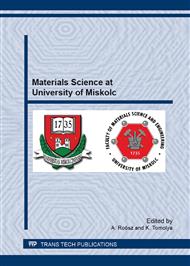[1]
D. Shangguan D., Lead-Free Solder Interconnect Reliability, first ed., ASM International, USA, (2005).
Google Scholar
[2]
K.J. Puttlitz, K.A. Stalter, Handbook of Lead-Free Solder Technology for Microelectronic Assemblies, first ed., Marcel Dekker Inc., New York, USA, (2004).
DOI: 10.1201/9780203021484
Google Scholar
[3]
K. Zeng, K.N. Tu, Six cases of reliability study of Pb-free solder joints in electronic packaging technology, J. Mater. Sci. Eng. R, (2002), R38: 55-105.
DOI: 10.1016/s0927-796x(02)00007-4
Google Scholar
[4]
S. Brown, Fatigue Resistant Lead-Free Alloy For Under Hood Applications, J. OnBoard Tech., June 2008, pp.31-36.
Google Scholar
[5]
P. Cusack, T. Perrett, The EU RoHS Directive and its implications for the plastics industry, J. Plastics, Additives and Compounding, Vol. 8, Iss. 3, (2006), pp.46-49.
DOI: 10.1016/s1464-391x(06)70584-0
Google Scholar
[6]
S. Biligiri, RoHS screening via XRF technology: A guideline to selecting systems: Available tools can help facilitate measurement of concentrations of select metals to ensure compliance, J. Metal Finishing, Vol. 105, Iss. 4, (2007), pp.29-33.
DOI: 10.1016/s0026-0576(07)80583-6
Google Scholar
[7]
M. Bos, J.A.M. Vrielink, Constraints, iteration schemes and convergence criteria for concentration calculations in X-ray fluorescence spectrometry with the use of fundamental parameter methods, J. Anal. Chim. Acta, 373 (1998) pp.291-302.
DOI: 10.1016/s0003-2670(98)00412-7
Google Scholar
[8]
J. Sherman, The Theoretical Derivation of Fluorescent X-Ray Intensities From Mixtures, J. Spectrochim. Acta 7, (1955) pp.283-306.
DOI: 10.1016/0371-1951(55)80041-0
Google Scholar
[9]
G.R. Lachance, R.J. Traill, A Practical Solution to the Matrix Problem in X-Ray Analysis, Canadian Journal Spectroscopy, Vol. 11, (1966) pp.43-48.
Google Scholar
[10]
G. Izuta, T. Tanabe, K. Suganuma, Dissolution of copper on Sn-Ag-Cu system lead free solder, J. Soldering & Surface Mount Technology, (2007) Vol. 19, Iss. 2, pp.4-11.
DOI: 10.1108/09540910810836484
Google Scholar
[11]
D.C. Montgomery, E.A. Peck, G.G. Vining, Introduction to linear regression analysis, fifth ed., John Wiley & Sons, New Jersey, (2012).
Google Scholar


